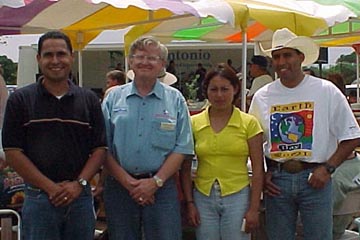Palo Alto College, in partnership with a Mexican university, has grand plans to initiate a clean-up of a contaminated lake near the cities of Tula and Tepiji, about 40 miles north of Mexico City.

Carlos Lucho Constantino, Thomas Smith, Margarita Guadarama
and Roger Cumpian III attended Eatrh Day. Photo
By Melissa Ruiz
On May 20, 2001, a small group of faculty and students led by Thomas Smith, Interim Chair of Applied Science and Technology and instructor of Environmental Technology, will travel to Tula-Tepiji, Mexico. Environmental Technology students accompanying Smith are freshman Richard Velasquez and John Garza, and sophomores Rima Menchaca, Roger Cumpian III, Joe Silva and Manuel Luna.
For five days, the Palo Alto delegation will work with their counterparts at UTTT to help develop strategies to repair the damage done by years of unregulated waste disposal, mining, industrial development and urban growth.
Luna originally had
plans to become a veterinarian. After getting involved with the Earth
Club, he could see a bigger picture. “If I can help save their habitats,
I will be helping more animals than I could as a vet,” Luna said.
Now the president of the Earth Club at PAC, Luna is excited about the
opportunity to be part of such a vital mission.
The trip will be the focal point of a new certificate in International
Environmental Management. According to the Workforce Education Courses
Manual, Palo Alto is the only community college in the state to have the
special international certificate, which will be offered during the Maymester
term.
The expedition to UTTT is being funded by a grant from the International
Consortium for Educational and Economic Development. Smith was taken on
a tour of the Endho Dam Project in November 2000.
The dam was created in the 1940s to provide irrigation water to area farmers.
Even though the lake is located north of Mexico City, it is at a lower
elevation and receives approximately 70 percent of its flow from Mexico
City as untreated urban runoff and wastewater.
With a population estimated at 22 million, Mexico City is one of the largest
cities in the world. However, the lack of a proper waste management program
and a poor drainage system has polluted the water of Endho Lake to an
unsafe level.
Smith stresses that solutions must be found to protect the health and
safety of the people who live and work around Tula-Tepiji, but also the
consumers of their produce. It is not known at this time if any of the
produce reaches the United States.
Accompanying Smith will be William Daugherty, Instructor of Logistics
Management at Palo Alto, and several logistics management students. They
will research Mexican transportation, warehousing and manufacturing firms.
Their research could shed light on the distribution of agricultural products
grown in the Tula-Tepiji area.
“When we get down there, I am expecting the worst,” said Luna.
“We have information about suspected health problems happening because
of the toxic water used for irrigation. One hundred years of pollution
cannot be cleaned up in one week. It will take years, but I’m willing
to do the job to the best of my abilities.”
Smith agrees, “This has become a major health issue. Even people
who live in Mexico can no longer drink the water. We have to raise the
level of awareness.”
On April 20, 2001 Margarita Guadarrama, a UTTT student, and Carlos A.
Lucho Constantino, a UTTT faculty member, toured Palo Alto College, attending
environmental classes, comparing science curricula and observing the ecological
setting of the PAC community. They were also able to participate in San
Antonio’s Earth Day celebration on April 21 at Woodlawn Park.
Constantino is hopeful the information gathered here will be used to improve
the conditions in Tula-Tepiji. “We gained much technical knowledge,”
said Constantino, “We have much work to do now."
“I want the two
colleges to work together,” Guadarrama said.
Constantino is hopeful the information gathered here will be used to improve
the conditions in Tula-Tepiji. “We gained much technical knowledge,”
said Constantino, “We have much work to do now.
Environmental Technologies majors learn to use the principles of science,
engineering, communications and economics to enhance natural resources,
protect the environment, prevent pollution and address health and safety
issues.
PAC now offers five different certificates in the Environmental Technologies
program: Environmental RegulationManagement, Environmental Compliance
Management, Water Resources Management, Environmental Project Management
and International Environmental Management.
PAC and UTTT realize that solutions to environmental problems are often
slow to materialize, but the teamwork of the joint effort will result
in a cooperative bridge that erases the border between the two countries.
While Smith is optimistic about this enormous project, he realizes the
adverse effects will take years to conquer. “I kind of feel like
David going up against Goliath,” said Smith.